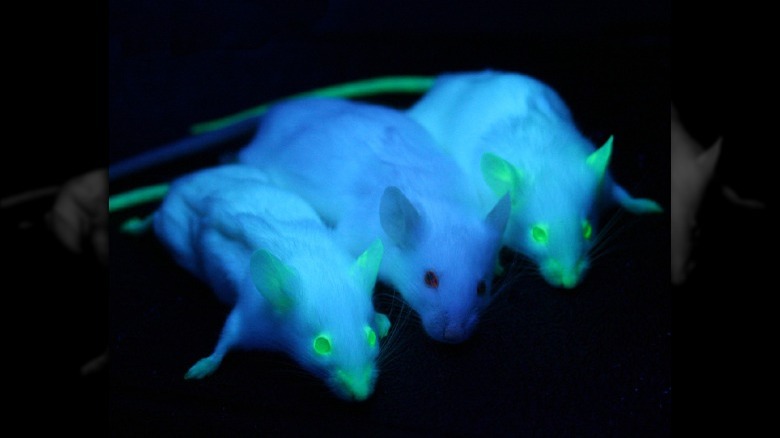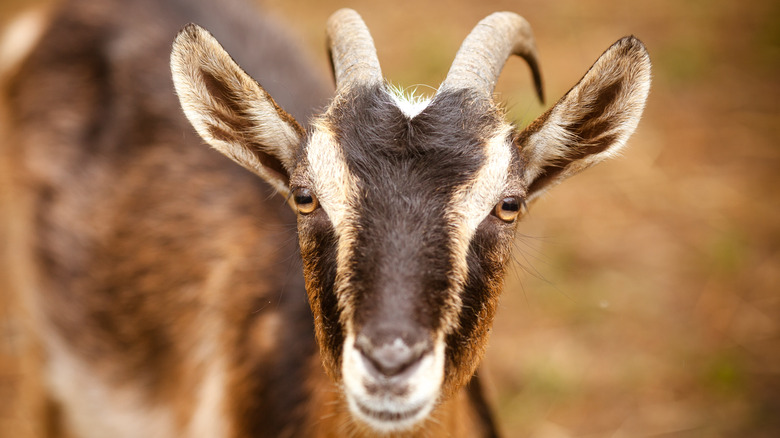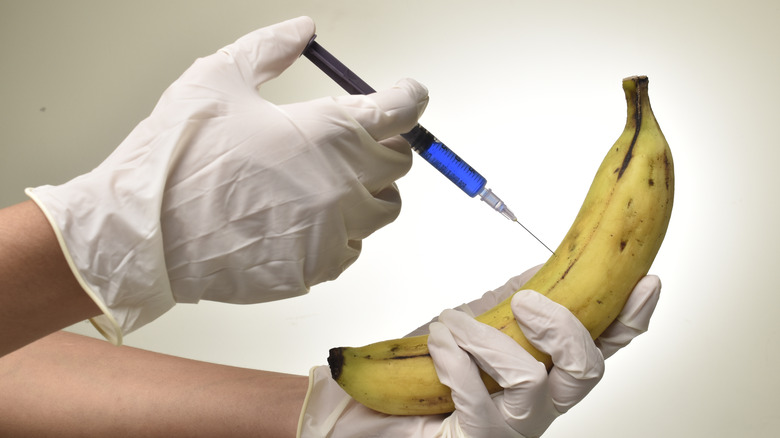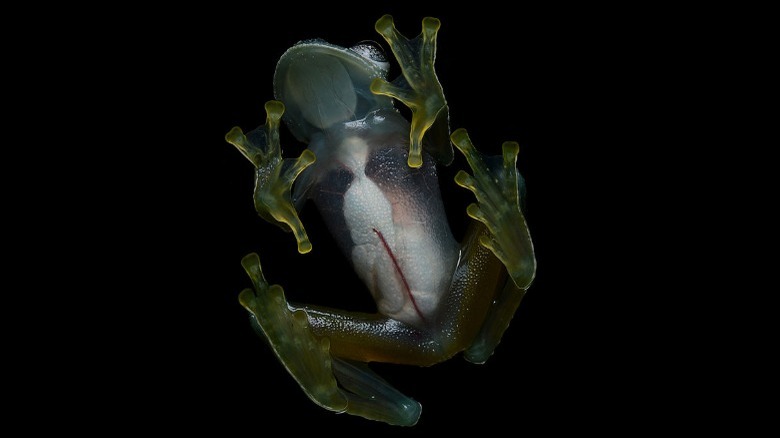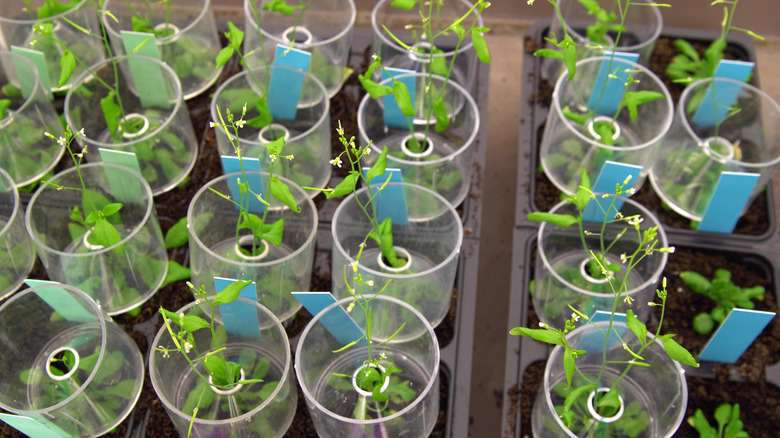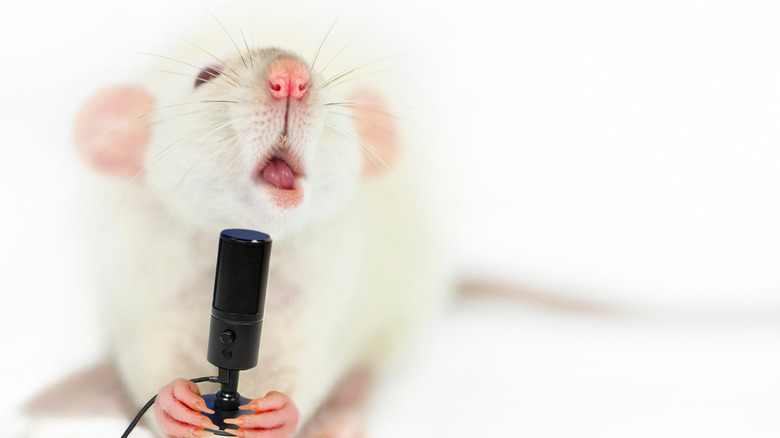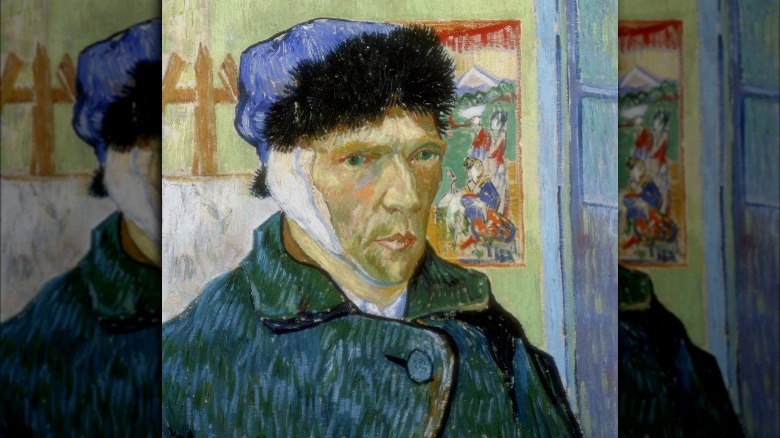The Most Bizarre Things DNA Has Been Used For
The world of science is wacky and wonderful. The things that scientists can do range from incredible, practical, and lifesaving, to absolutely strange and bizarre. Seriously, it's just great.
And that becomes even truer when you look into the stuff people are doing with genetics and DNA. Studying the fundamental code that gives life to everything can lead to some really weird pursuits, and new technologies — like CRISPR — that allow people to actively edit genetic material truly open the door for some crazy stuff. (That said, even without that sort of tech, genetic research has still turned out some great studies).
Maybe this is how we get things like chimeras? Or any of those combo-animals in "Avatar: The Last Airbender?" Well, in all fairness, we aren't quite there yet. (Sorry if that got your hopes up). But nonetheless, scientists (and others) have cooked up some pretty weird ideas when it comes to applications of DNA.
Animals that glow in the dark
Okay, on the surface, this might not seem all that weird. Just take a look at the deep ocean. Bioluminescence is definitely a thing (and it's seriously cool). But no, this is a reference to research that's made animals that could be everyday house pets — dogs, cats, rabbits — glow like glow sticks. For real. Each of these animals were the subject of their own experiments; The Guardian reported on the glowing rabbits, created by researchers injecting DNA from jellyfish into rabbit embryos, which were then put back into the mother rabbit. The white rabbits would glow green as soon as the lights went out.
The dogs and cats have a similar story. The MIT Technology Review says that the process of genetically engineering cats this way was surprisingly easy, involving the addition of a fluorescent gene into the eggs of normal cats, while New Scientist specifically says that the glowing gene for the dogs came from sea anemones. In both cases, the animals glowed — the cats were green, while the dog, named Ruppy, glowed red under UV light — and could produce offspring that also glowed.
All that said, making glowing animals was never really the point in any of these cases. Generally, they're just proofs of concept when it comes to genetic engineering, and are largely steps on the way to more effective medical research.
The Amazing Spider-Goat
What do you think would happen if a goat got bitten by a radioactive spider? Maybe the goat becomes capable of great feats of strength, swinging around the city from lines of spider webs shot out from its hooves?
Okay, probably not (if anything, you'd probably just have a dead goat, were radioactive spiders even possible). But, according to Phys.org, the whole idea of goats producing spider silk actually isn't a weird comic book-inspired fever dream. Researchers experimented with inserting the spider gene for producing silk into the genetic code of goats, and then some of the goats started producing spider silk proteins in their milk. Not in extremely high quantities, mind you — they're still producing milk, not literal spider webs — but it's spider silk nonetheless, and in higher quantities than would be possible with spider farms. (And, if anyone's concerned, the goats were totally fine).
It seems like a really random thing to try, but there's a good reason for it. Per C&EN, spider silk is incredibly desirable as a raw material for things like clothing, but also medical devices. It's strong but stretchy, waterproof, and renewable — a lot of great properties that make it useful in a bunch of different fields. It's just been hard to produce in bulk; that's where the goats make things a lot easier.
Vaccines that you can eat
For a while, it looked like bananas might be the answer to disease.
Yes, you read that right. New Scientist explains that, back in the 1990s, there was this idea that bananas could be used as effective vessels for vaccines. Initial tests with potatoes proved that a little bit of genetic engineering could create potatoes that triggered immune responses in rats. That led to similar experiments to create foods that produced antigens found on the outside of viruses (and thus act like vaccines), but potatoes had to be boiled (which would destroy the vaccine). That's where bananas came in. They didn't have to be boiled, and were grown all over the world, which was just perfect. These genetically altered bananas could be given to people in developing countries who would normally have a hard time getting expensive vaccines. Feeding it to their kids could, potentially, vaccinate them against a bunch of different diseases: hepatitis B, measles, polio, and so on.
That said, according to How Plants Work, that didn't really pan out. There were a bunch of troubles along the way, including tricky government approval, and problems like food allergies. Still, the idea didn't get forgotten, just changed, with some plants being used as biological factories for other types of pharmaceuticals.
Frogs with transparent skin
When it comes to weird feats of genetic engineering, there seem to be a lot of stories that end up being about unique animals made in labs. Transparent frogs are another one of those cases.
A research paper describes the whole experiment. In essence, The team was working with a particular type of Japanese frog, looking for the ones with the least amount of pigmentation in their skin (there's a bunch of science about how skin pigmentation works, but, basically, just the palest ones). They would selectively breed those together and repeat the process with the offspring (via Daily Mail). Eventually, they ended up with a few frogs that, from some angles, just looked really pale, but were actually transparent from other angles. They could see the internal organs: the heart, stomach, liver, lungs, and so on.
It's a super bizarre but surprisingly helpful advancement. Since the frogs were transparent from birth, the team could watch the development of the internal organs throughout the frogs' lifespans. They didn't have to dissect the frogs or anything, which would've usually been the case to, you know, see what's going on inside. Plus, they have plans to combine this with fluorescent pigment, which would also let them do things like watch cancerous tumor growth over time.
Detecting land mines with plants
Getting rid of landmines would be a really helpful thing, and that doesn't seem like too controversial a statement. It's the "how" that gets to be a bit of a problem, but some scientists seem to have figured it out. Per Nature, a group of researchers used a bit of genetic engineering to mess with a plant called thale cress. The plant already turns red in the autumn by releasing a red pigment, so the trick was just to make those pigments release on a different trigger: the presence of nitrogen dioxide gas. Underground landmines apparently produce the stuff, and so these genetically engineered plants would turn red if one was nearby. It's an elegant solution that could clear away landmines from huge swaths of land really quickly.
That said, though, PopSci doesn't fully agree with how useful this finding is. Planting and tending to these plants range from difficult to impossible (they're designed for fields that are expected to be riddled with landmines, after all), so, at best, you'd have to just hope that the plants are able to grow in whatever environment they're planted in. Plus, the team has actually admitted to not knowing how sensitive these mechanisms are, so reliability is a glaring issue (and a false negative could be deadly).
All in all, it's interesting, but maybe not the best solution ever.
Concocting the perfect perfume for you
According to Wired, the company My DNA Fragrance really took the idea of DNA-based consumer products to a new level in the late-noughties. Basically, what they did is take your DNA sample and create a personalized fragrance based on your genetic code.
But the company did more than just make perfumes based on the DNA samples sent in. The Guardian mentions that this company also went ahead and started advertising fragrances made from the DNA of celebrities, including Michael Jackson, Albert Einstein, Barack Obama, and others. And all of these perfumes have their own special names; Einstein's was called "IQ," Katherine Hepburn's was "Monarch," and Obama's was "POTUS 1600."
As for the science... well, that's a little questionable. Supposedly, they used a "Mitochondrial DNA process" which could extract DNA "from hair shafts with or without the follicle intact." It's a strange set of words that doesn't really mean much. On top of that, they didn't actually explain how your DNA creates some unique scent; maybe it enhances your natural features, or maybe not. It's kind of a black box of a process, but the DNA got used somehow.
Reviving the dead (or, rather, the extinct)
Basically, just think of "Jurassic Park" here. Scientists have found a way to potentially do something similar.
Granted, though, this isn't a case of cloning. Science and National Geographic explain that this is through the marvels of genetic engineering and, specifically, the introduction of CRISPR technology. When the remains of ancient species, like woolly mammoths or passenger pigeons, are found, their DNA can be sequenced (in the same sort of way the human genome can). Then, it's pretty easy to find their closest living relative; in the case of the woolly mammoth, that would be the Asian elephant, which shares about 99% of its DNA with the mammoth. Then that's where CRISPR comes in. Just splice the unique mammoth DNA into the elephant DNA. Essentially, you'd be able to recreate the woolly mammoth on a genetic scale. And that's not the only animal this would work for; more recently extinct species are also fair game for this whole de-extinction process.
Of course, nothing is quite that simple. While the genetics seem to check out, there are other issues. Introducing species into new environments can have huge effects on the ecosystem, both for the better, and for the worse. So when it comes to reviving an extinct species, it's hard to say for sure.
Mice that sing like birds
On a list that's all about weird results of genetic engineering, it seems like this should be about some sort of mutant mouse-bird hybrid, but that's not the case. These singing mice were actually a complete accident.
The story goes like this: Japanese scientist Arikuni Uchimura was working with some genetically modified mice (via Phys.org). But they weren't modified to sing; the modifications were such that, when the mice had offspring, they were likely to miscopy DNA and thus cause mutations (the engine behind evolution). Uchimura was breeding them just to see what would happen, but was expecting physical mutations (which, to be fair, he also did see). One day, though, he walked in to find one of the mice singing and chirping like a bird, despite mice usually communicating with ultrasounds. And that was completely by chance.
It ended up leading to further research about language development and societal influence, which could lead to more understanding about human linguistic developments, too. Oh, and Uchimura also said that he has "hopes of making a Mickey Mouse someday," which is sort of understandable.
Growing brains of humanity's closest relative
Neanderthals are pretty widely thought of as humanity's closest relative, but that idea just raises more questions about what actually differentiates us. Of course there are things like fossils and archaeological finds (per The Guardian, Neanderthals actually created cave art) but genetic research is taking things further.
In essence, the discovery of Neanderthal remains means that the DNA of our close relatives has been sequenced and compared to our own (they really aren't all that different. A decent amount of Neanderthal DNA is still floating around in the human genome). So it's very possible to know just what it is that makes us different on a genetic level, which has led to the use of CRISPR technology to splice certain genes into other animals' DNA, to see what practical differences arise from the genetic ones.
Trying this with the brain is the next step, and later studies (reported on by Nature) did just that. The Neanderthal version of a gene was introduced into a human stem cell, which was cultivated into brain cells. The cells were allowed to multiply, forming brain organoids (clumps of brain tissue, but not full brains) which looked different than normal human brain cells: smaller and jagged, rather than round. That doesn't answer the question of how Neanderthals thought, but it's a step, and one that involves growing little tiny brains in a lab.
Making dating just a little easier
Are you tired of Tinder? Or the whole host of other online dating sites and apps that just aren't helping you find your one true love? Well, if you'd thought of it before 2019, you could have turned to the dating app Pheramor and left things up to science.
Wired explains that Pheramor let you send in a cheek swab, and they would sequence your DNA. Then, they'd set you up with a profile on their app and show you a bunch of people who were compatible with you based on your two respective genetic codes. The ticket to it was the idea that "opposites attract," with people supposedly being more attracted to someone who has vastly different DNA. Pheramor also cited studies — like the "Sweaty T-Shirt Experiments" — that link smell, pheromones, attraction, and DNA. Basically, people will be more attracted to the pheromones of someone who is the most genetically different to them, specifically in one part of one chromosome. Hence, opposites attract, finding love via DNA. Yay!
But, before you lament the passing of Pheramor, know that you would have had to take their science with a grain of salt. Other researchers say that pheromones are still entirely theoretical, and this idea of "opposites attract" on the genetic level is inconclusive. So maybe we can find love via DNA, or maybe not. Jury's still out on that.
Keeping the best of us alive in space
Did you know that, should the human race end in some fantastic calamity, Stephen Hawking is one of our designated survivors, stowed away on a back-up drive up on the International Space Station?
It sounds insane, no doubt, but it's a real thing. According to We Are The Mighty, a game developer named Richard Garriott put something together called the "Immortality Drive." It was meant to act as a time capsule of sorts, showcasing some of the greatest achievements of the human race, as well as a few personal messages (via ABC News). In 2008, Garriott got the chance to blast into space for the ISS, taking the Immortality Drive with him.
The drive didn't get its name lightly. Because aside from being a time capsule, it's also literally a weird step toward immortality, bearing the DNA sequences and genetic codes of a handful of notable humans. That includes Stephen Hawking, as mentioned above, but also Stephen Colbert, Lance Armstrong, and others. Essentially, it can act as a back-up drive for the entirety of humanity. Should benevolent aliens find the drive, they could, hypothetically, restart the human race.
Leather made of... human skin?
Sounds like a horror movie, doesn't it? The idea of wearing human skin as a fashion statement sounds macabre, but it's not impossible.
According to Smithsonian Magazine, a designer by the name of Tina Gorjanc has filed for a patent that, all told, would allow her to create clothing from actual human skin. The plan involves using the DNA of designer Alexander McQueen, who reportedly included a lock of his own hair in the labels for a number of his works. That's a source of his genuine DNA, and with that genetic code, it would theoretically be possible (though difficult and costly) to grow McQueen's skin from that little DNA sample. That skin could technically be tanned and turned into, essentially, leather for jackets and bags.
Understandably, some people were completely grossed out (maybe "horrified" is a better term), though McQueen's representatives were alright with the idea. If you're disgusted, though, worry not. This isn't actually going through. According to Allure, Gorjanc did file those patents, and, should they get approved, could hypothetically continue with this project. But really, she's not planning to commercialize anything; it was all just a statement about how poorly protected genetic information is. A piece of hair or a cigarette butt — there's genetic material there, and anyone could pick it up and do whatever they wanted with it. Given we can grow human skin, it's a valid concern.
Growing Vincent Van Gogh's ear
You're probably familiar with the name Vincent Van Gogh, in which case, you might've heard that story about him cutting off his ear. If not, well, there's your context right there, because as of 2015, you could've gone to see his ear in person. Don't freak out; it's not his real ear. Not really. According to Smithsonian Magazine, New York hosted a piece of art called "Sugababe," a pale, artificially grown ear held suspended in gel (hooked up to computers so it could "hear" in real time).
Diemut Strebe was the mastermind behind this, getting into contact with Lieuwe van Gogh, a descendent of Vincent van Gogh's brother, as well as a descendent of van Gogh's sister (via CNNHealth). He convinced both to donate DNA samples to the project (one for the main DNA, and the other for mitochondrial DNA, because they get passed down differently). Then he teamed up with MIT scientists, who helped him merge those genetic codes and build a scaffold to grow the cells on, approximated into the shape of an ear.
The result? An actual Vincent van Gogh ear, grown in a lab from donated DNA. It's just as creepy as it sounds.

